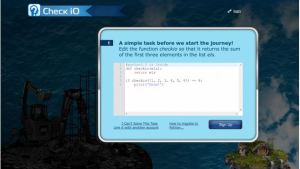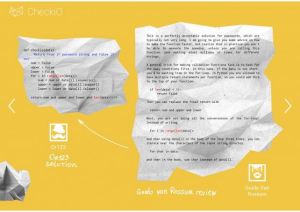By looking at the variety of online services for wannabe programmers, it seems like nowadays it is easier to learn how to code than how to cook. There is, however, not much of gamified experience for those who know the craft but still want to stretch their brains instead of playing another few hours in WoW or LoL.
Those bored coding enthusiasts are the main audience pursued by CheckiO, a Techstars-seasoned Ukrainian-born startup based in Las Vegas. After two years of flying under the radar and raising $750,000 in seed funding in November 2013, the startup is aiming at a leading position in the barely touched niche of code gaming.
Until today, CheckiO has been a place where Python developers could play a game by solving programming problems created by the startup’s team and divided into “islands.” In addition to that, the most lucky programmers could even get their code reviewed by Guido van Rossum, the creator of the Python language and CheckiO advisory board member.

Now the platform turns to crowdsourcing in three different ways. First of all, starting from today everyone can create a new coding puzzle and suggest it to CheckiO through GitHub, while the team’s responsibility is to choose ones that make sense and pull them into the game.
In addition to that, CheckiO has announced an effort to crowdsource the problems’ translations. The function has been in beta for the last two months, and with quite good results — currently users can already access the puzzles in 10 languages.
The third part of the new offering is hints, which players can leave to those who will be solving a particular problem later.
Currently CheckiO has about 40,000 users from all over the world with a particularly significant community in Japan. However, the life of the startup wasn’t easy from the beginning, as it grew from a hobby of its founder through a nearly-failed early-stage startup to a promising Las Vegas-based project.
We spoke to CheckiO CEO and co-founder Liza Avramenko about ups and downs of the startup’s history and its plans for the near future.
“I don’t know what Techstars is, but there’s an email from them”
The idea of CheckiO came to its founder and current CTO, Alex Lyabakh in 2011. Initially it was a place where users could solve a programming problem and the community could vote for the best and most beautiful solution.
After bringing Liza Avramenko aboard as a CEO, the idea went further.
“I’m not a coder, but when he described the idea to me it totally hooked me up,” she recalls. “It was a website with terrible design from the 90s, and together we decided to build a game on top of it.

“Once we built the game, we presented it on [Ukrainian startup conference] IDCEE 2012, but it was a failure — very few people in the audience were interested.”
Realization of improbability of raising funding in Ukraine turned the team to look for foreign investors through AngelList. However, first attempts weren’t too fruitful, and by the end of 2012 the team felt like they had failed miserably.
Everything changed when Lyabakh mentioned to Avramenko that he received a message from “something called Techstars, probably just spam,” as he put it.
“I started researching what’s Techstars, and realized it’s one of the world’s most famous accelerators!” Avramenko said. “They found us on AngelList and encouraged us to apply for the incubation program.”
Creating a community
After a while, CheckiO was accepted to TechStars’ acceleration program in Boston, which marked the second birth of the project. When the program was finished, the fresh alumni found themselves working as a distributed team from Ukraine, Russia, and the US.
“Our co-founder in Russia is so passionate about creating coding and creating coding puzzles that people all over the world track his every GitHub move to get a chance play his games first (even before they are published),” praised Avramenko her co-workers. “Our designers are among of the most talented ones in Ukraine, and most important is our dev team that has some of the strongest and smartest developers in the country.”

However, many of potential investors weren’t particularly happy about the startup’s origins.
“Being a female CEO from Ukraine, it was very hard for me to raise funding,” Avramenko said. “They said ‘you can’t build a big company with a distributed team,’ or ‘you’re connected to Ukraine — oh, you will be raided,’ or even ‘a woman as a CEO can’t manage anything.’
“For a couple of months I couldn’t find funding. But you need to keep doing it, the main thing is not to give up and not to get disappointed when people refuse you. After you get the first investor, it’s much easier to find next ones.”
After finally landing a $750,000 seed round from Ukrainian and American investors and moving to Las Vegas, the team’s main goal became to introduce new features to the platform and build a healthy community around it.
A big step in that direction was bringing on CheckiO’s advisory board the Python creator Guido van Rossum, who’s currently working at Dropbox.
“From time to time, he does code reviews for our users,” Avramenko said. “We select one of the most active users, send his solution to a puzzle that he wants to show Guido, and literally Guido breaks down the code line by line writing a paragraph on how each line could’ve been done better. Users are very excited.”

The strategy of bringing prominent people has proved to be quite effective, so Avramenko says she’s looking for people with authority in the communities of JavaScript and Ruby, which are planned to be available on CheckiO together with Python by the end of 2014. The team also wants to include Apple’s Swift in the list, even though finding an expert in this one could be not so easy.
Learning by doing
In addition to popularity among coders worldwide, CheckiO is already being used by educational institutions to assess students and make homework more entertaining. Among the users are MIT, Georgia Tech University, University of Washington, and even University of Queensland in Australia.
“About a year ago, we received an email from a user saying ‘Please, urgently send me a confirmation that I’ve reached the level five in the game!’,” Avramenko said. “We sent the email, and then asked what happened. It turned out that a professor in the University of Texas told his students that if they reach the fifth level in CheckiO, he would grant them a C even if their exam result is lower.”
Education institutions represent a promising revenue stream for CheckiO, however Avramenko is not very optimistic about it.
“I worked in an American university, and I can say that the sales cycle in education in the US is very slow. I’d rather do it for free, to get more users.”
Another non-profit educational project CheckiO are ready to take part is related to their home country.
“There’s a very interesting initiative to change Ukrainian tech education, and we will work our asses off to help Ukraine in this situation,” Avramenko said.

Being a Codecademy student herself, Avramenko is sure that its methods are still not effective enough to teach people coding skills.
“There’s a lot of people who finish Codecademy and don’t know how to code,” she said. “It gives them a monkey see, monkey do approach: type this function here, type that function there etc. In order to learn how to code, you need to complete projects.”
Time to see the money
CheckiO, however, does not cater to an audience of absolute beginners — even to register there, users have to write a simple Python function. Being therefore a community of more or less advanced coders, the startup has a few interesting ways of earning money.
As Avramenko explained, CheckiO currently has enough money for the next 10 to 12 months, however there are already a few monetization options it’s going to experiment with.
First of them is making a set of tools for recruiters to screen candidates and check their code. At the same time, potential employers can see in the candidate’s profile how active he or she is in the community, which makes it something of a hybrid of GitHub and StackOverflow.
Another way is working with software crowdsourcing, i.e., becoming a “permanent online hackathon platform.” In the near future, interested companies might be able to give their real world problems to the coders to play with.
The third way CheckiO is considering is in-game purchases. Although Avramenko promises that the game will always be free to play, there are plans to introduce a internal currency, which players could earn by unlocking in-game achievements or just purchase for real money. Users will be able to spend the currency paying for code reviews or accessing special job boards.
In addition to monetization, this year Avramenko plans to completely revamp the game’s interface and also finally learn how to code to be able to solve problems in CheckiO.
“I’m a Codecademy student, so I shared my profile with my team. Now they check it every day and keep asking — Liza, where’s your progress?!”